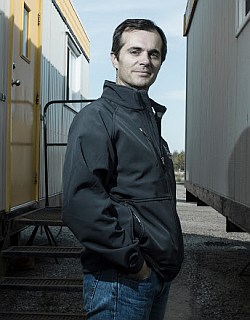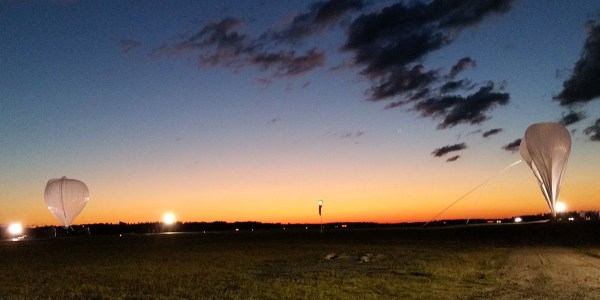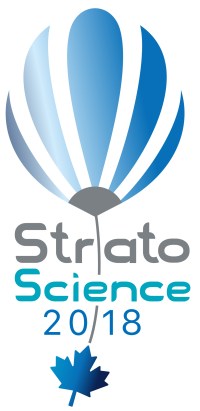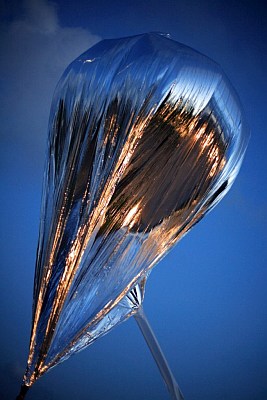News Archive
-
May 6 2018
The present and future of the French balloon program: an interview to Stéphane Louvel
To know more about the present and future of the French Balloon program I've made a brief interview to Stéphane Louvel, mission manager of the CNES stratospheric balloon campaigns all over the world. The interview contains in white dotted text boxes, some context information to those questions requiring it. Hope you will enjoy it.

About the interviewee
After a Master of Science in Meteorology and Atmospheric physics, Louvel received his Ph.D. degree in Applied Mathematics from Toulouse University of Science (France) in 1999. He worked for the French Space Agency (CNES) during the last 17 years. His career started with balloon operational activities as meteorological engineer, then he was appointed as Flight Safety Officer in the Europe’s Spaceport of Kourou and later he was in charge of verifying the compliance of Ariane, Soyuz and Vega launchers with the new French Space Operations Act. Now he is mission manager of the CNES overseas stratospheric balloon campaigns.
Stratocat: Stephane, tell our readers what kind of work you make for the CNES balloon program.
Stephane Louvel: For more than 4 years, I am the mission manager of the Centre National d’Etudes Spatiales (CNES). My job is to organize each year a new balloon campaign according to the scientific community for stratospheric flights, especially with Zero Pressure Balloons. Owing to the French population density, we have to perform all balloon flights abroad but this constraint is also an opportunity for the scientists to study atmosphere from several sites all over the world. So, I begin to work with the scientific need, to find the best site for this kind of flight, to make agreements with the host countries, to organize and to integrate scientific instruments on adapted gondolas, to define each balloon and the associated flight train configurations, to verify their compliance with the safety requirements, to schedule the logistic aspects and finally to manage the operational team to perform the flights in accordance with the scientific objectives and the safety constraints.
Since it's inception the CNES balloon program performed it's domestic launch activity from two bases, Aire sur L'Adour located in the department of Landes, in the southwest part of the country, and Gap-Tallard, in the Hautes-Alpes department of the Provence-Alpes-Côte d'Azur region.
Since June 2009 both bases were inactive as a result of an increment in the failure and safety requeriments on regard scientific ballooning.
S: What is the current situation of the CNES balloon program now and what impact had the opening of the Timmins balloon launch base in Canada?
SL: After more than five years of development and qualification, the operational CNES balloon activities were resumed two years ago. The New Operational System for the Control of Aerostats (NOSYCA) is especially adapted to the Zero Pressure Balloons and allows flying up to 40 km high with a scientific gondola up to 1 ton. This operational system has a fail-safe architecture and was fully qualified after two test flights in 2013. Two S-Band stations are implemented to extend flight area enabling to control the aerostat from the launching base and also from a remote station if it is needed. In parallel of these technical developments, CNES and Canadian Space Agency (CSA) set up an agreement for performing balloon flights from Timmins, mid latitude in the Northern hemisphere, offering a new opportunity of balloon flights for the European and the Canadian scientists. The associated arrangement states the responsibility of CSA to build the launch facilities, technical buildings and launch pad specified by CNES, and CNES to make the commitment to perform two flights per campaign, dedicated to the Canadian experiments, within the coming ten years.

Both STRATO SCIENCE campaigns of 2014 and 2015 took place between the middle of August until the end of September. 13 flights has been performed and the goal is to take advantage of the turnaround period in the stratosphere and perform flights Westward at the end of August, around Timmins in the beginning of September when there is no wind at high altitude, and Eastward at the end of September. The geographical breakdown in this surrounding area and these specific meteorological conditions allow offering to our scientific community flights with atmospheric slow descent or high level ceiling in a same balloon campaign.
S: Can you explain which is the actual status of Aire sur L'Adour and Gap-Tallard bases?
SL: The flights from both sites became more and more difficult with respect to the safety requirements. Inhabitant density and number of roads prevent to perform flights in safe conditions, except for sounding balloons with payload mass under 3 kg. Regarding Gap's facilities when they were active, CNES owned a building there and rented another one on each campaign. Althought the CNES logo is still hanging in the building, about 10 years ago, CNES sold all their belongings in the airport. At this time, no balloon campaign is scheduled in Gap so Aire-sur-l’Adour is the only one CNES operational base in France. We perform regularly sounding balloons for French scientists there. All the operational team works on this site, the Nosyca system is maintained, qualified and stored at this place and we perform the entire technical tests on this base.
S: CNES was allways a very diversified program in terms of territory, performing balloon campaigns in every continent. That was changed with the opening of Timmins base...?
SL: No. In August and September 2016, we were back in Kiruna (Sweden) for 2 scientific flights. We could verify the compatibility of our new operational system with the Esrange infrastructures and also with the new NIMA S-band antenna installed on Radar Hill in front of the launch pad. Kiruna stays the main European balloon base for CNES flights and the easier to access with a reduced volume of freight transport.
During March and April 2017, the last balloon campaign took place in Alice Springs in the middle of the Australian desert. With more than 120 tons of freight, we were able to install our larger ground configuration: an independent power supply architecture, a S-band antenna with another remote telemetry station in Longreach (1000 km East from Alice Springs), a meteorological station, a control center linked with our operational room and everything needed to prepare and to launch 3 stratospheric balloons with big payloads, especially more than 1 ton for the PILOT telescope with 30 hours of flight close to 40 km of altitude.
S: What activities are planned in the near future?

SL: We are now working for the next Canadian balloon campaign scheduled in summer 2018, always in cooperation with the CSA team and on the Timmins base. We plan to perform 5 flights during this campaign for atmospheric science or Astronomy associated with some new technology devices, by example the first flight of the 4G+ communication module designed by AIRBUS Defense & Space. This campaign can be also an opportunity for technologic instruments from Canadian universities to make their first flight in the stratosphere.
For the next coming years, CNES plans to be back in Timmins in 2019 to perform the third PILOT flight and also the first HEMERA flight dedicated to new European scientists. A balloon campaign in Kiruna is scheduled for 2020 with the second HEMERA flight and probably our first transatlantic flight between Kiruna and the North of Canada. In parallel, in the framework of the HEMERA project, we are also working to develop a new equatorial base in response to the numerous European and Canadian scientific requests to study tropical deep convection, large storm cells and all the parameters that could have an impact on the climate change… this is our new challenge for 2020-2021.
S: CNES has identified yet what countries/places could be candidates to host these equatorial launches?
SL: In the framework of HEMERA, several new sites will be analyzed because each country has different interest. In 2017, CNES initiated a consultation of all the French laboratories, mainly in atmospheric sciences, to understand their needs. In addition to Timmins and Kiruna, all the French laboratories showed interest to fly in the equatorial zone and especially in South America. So we are working to find the best place for stratospheric flight in the North part of Brazil between equator and 10° south.
The following question to my interviewee may need some context for our readers.
At the beginning of the 70s the French atmospheric research program needed to find a new platform that was versatile and adaptable to any climatic circumstance (the Arctic, the tropics, etc.), cheap, simple operation and above all that allowed the realization of long-duration flights. Thus, after several years of study, scientists of the aeronautical service of the CNRS (Center Nationale de Recherche Scientifique) came to the conclusion that the original concept of the Montgolfier brothers (with hot air instead of gas) could be used to develop a new type of ball that would allow not only long-duration stratospheric flights, but also could make "vertical excursions" that is to change height with just opening and closing a valve and without carrying ballast.
The first two models of the aerostat, were manufactured using dark polyethylene to facilitate the absorption of solar heat. They were tested in 1977 and demonstrated good performances, however, none of them survived the critical night stage. To solve this, they devised an ingenious solution: counteract the cooling of the aerostat by the absorption of infrared radiation from the Earth.
The new prototype that was christened MIR (acronym of Montgolfier Infra-Rouge), instead of being manufactured of dark material, was composed of two well-differentiated hemispheres: the bottom of transparent polyethylene, which facilitated the passage of telluric radiation, and the upper part made of aluminized mylar forming a cavity that allowed the retention of heat absorbed by the balloon, raising the internal temperature and giving it greater lift.
For many years, the MIR performed round the world flights from many places on earth allowing the acquisition of valuable data for many branches of science but especially for the atmospheric sciences.
S: ¿What is the status of the MIR balloons right now? There is a certain date to their return to the ballooning scene? Of what depends?

SL: Scientists always have interest for MIR balloons but a lot of them find also opportunities on Zero Pressure Balloons (ZPB) or small pressurized balloons. About operational aspects, the main constraint for MIR flight is to become compliant with the safety rules, especially to be able to manage the end of flight and to find a safe zone for landing. In case of cold night with high clouds, the balloons can descent irremediably in a no carefully chosen zone. Meteorological model could be developed and particular criteria could be studied but this is not a priority for CNES at this time.
In term of priority, the next improvement of the NOSYCA system will be associated to the small ZPB with the objective to perform dedicated flights with small payload gondolas (between some kilograms up to 100 kg) during some days. This development will begin next year and will last about 3 years. At the end, this new improvement can be adapted to the MIR balloons if it is needed.
S: In July 2016, CNES performed a test launch from Aire...as far as I know testing the possibility of the recovery of payloads from the sea... What details can you offer on the test and which is the status of that proposal of operations now?
SL: In July 2016, we planned to perform a small flight from Aire-sur-l’Adour for testing a waterproof configuration of our flight train in case of scientific demand for a flight over the sea and then a sea recovery. Just before the Kiruna campaign in August, we don’t find suitable wind for a flight over the Atlantic sea and we decided to perform only a short flight to certify the operational facilities of the base with a local recovery in the adjacent region. A real flight over the Atlantic sea is not scheduled at this time but a waterproof flight train can be a reasonable option for the next Canadian campaign in case of lakes or flooding area.
-
Share this on social media


